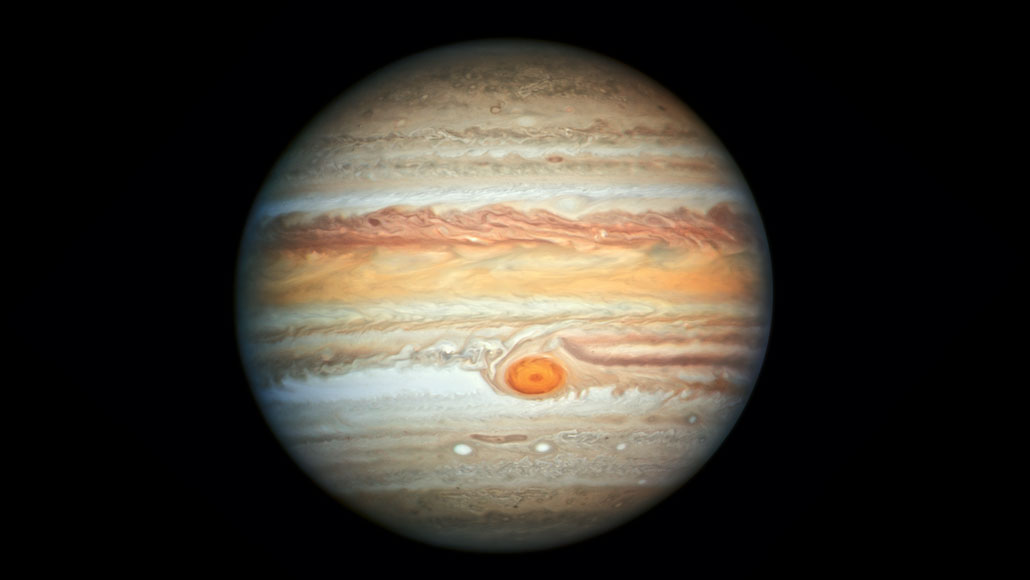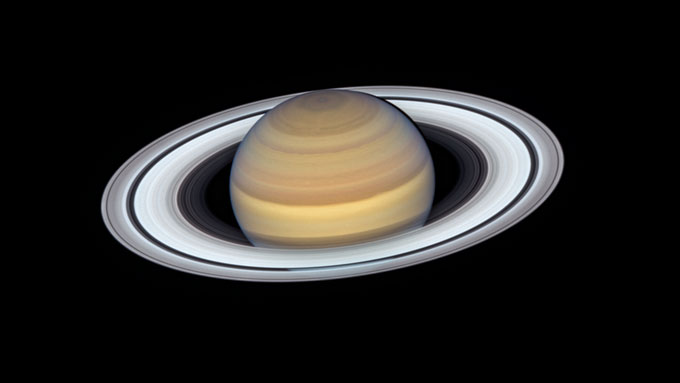A shadowy birthplace may explain Jupiter’s strange chemistry
A frigid planetary nursery could account for the gas giant’s peculiar atmospheric composition

Jupiter’s atmosphere has abundant nitrogen, argon, krypton and xenon, suggesting that the giant planet formed in a very cold place.
NASA, ESA, A. Simon/GSFC, M.H. Wong/UCB
By Ken Croswell
- More than 2 years ago
Read another version of this article at Science News Explores
Jupiter may have formed in a shadow that kept the planet’s birthplace colder than Pluto. The frigid temperature could explain the giant world’s unusual abundance of certain gases, a new study suggests.
Jupiter consists mostly of hydrogen and helium, which were the most common elements in the planet-spawning disk that spun around the newborn sun. Other elements that were gases near Jupiter’s birthplace became part of the planet, too, but in only the same proportions as they existed in the protoplanetary disk (SN: 6/12/17).
Astronomers think the sun’s composition of elements largely reflects that of the protoplanetary disk, so Jupiter’s should resemble that solar makeup — at least for elements that were gases. But nitrogen, argon, krypton and xenon are about three times as common on Jupiter, relative to hydrogen, as they are on the sun.
“This is the main puzzle of Jupiter’s atmosphere,” says Kazumasa Ohno, a planetary scientist at the University of California, Santa Cruz. Where did those extra elements come from?
If Jupiter was born at its current distance from the sun, the temperature of the planet’s birthplace would have been around 60 kelvins, or –213˚ Celsius. In the protoplanetary disk, those elements should be gases at that temperature. But they would freeze solid below about 30 kelvins, or –243˚ C. It’s easier for a planet to accrete solids than gases. So if Jupiter somehow arose in a much colder environment than its current home, the planet could have acquired solid objects laden with those extra elements as ice.
For this reason, in 2019 two different research teams independently made the radical suggestion that Jupiter had originated in the deep freeze beyond the current orbits of Neptune and Pluto, then spiraled inward toward the sun.
Now Ohno and astronomer Takahiro Ueda of the National Astronomical Observatory of Japan propose a different idea: Jupiter formed where it is, but a pileup of dust in between the planet’s orbit and the sun blocked sunlight, casting a long shadow that cooled Jupiter’s birthplace. The frosty temperature made nitrogen, argon, krypton and xenon freeze solid and become a greater part of the planet, the scientists suggest in a study in the July Astronomy & Astrophysics.
The dust that cast the shadow came from rocky objects closer to the sun that collided and shattered. Farther from the sun, where the protoplanetary disk was colder, water froze, giving rise to objects that resembled snowballs. When those snowballs collided, they were more likely to stick together than shatter and thus didn’t cast much of a shadow, the researchers say.
“I think it’s a clever fix of something that might have been difficult to rectify otherwise,” says Alex Cridland, an astrophysicist at the Max Planck Institute for Extraterrestrial Physics in Garching, Germany.
Cridland was one of the scientists who had suggested that Jupiter formed beyond Neptune and Pluto. But that theory, he says, means Jupiter had to move much closer to the sun after birth. The new scenario avoids that complication.

How to test the new idea? “Saturn might hold the key,” Ohno says. Saturn is nearly twice as far from the sun as Jupiter is, and the scientists calculate that the dust shadow that chilled Jupiter’s birthplace barely reached Saturn’s. If so, that means Saturn arose in a warmer region and so should not have acquired nitrogen, argon, krypton or xenon ice. In contrast, if the two gas giants really formed in the cold beyond the present orbits of Neptune and Pluto, then Saturn should have lots of those elements, like Jupiter.
Thanks to the Galileo probe, which dove into the Jovian atmosphere in 1995, astronomers know these abundances for Jupiter. What’s needed, the researchers say, is a similar mission to Saturn. Unfortunately, while orbiting Saturn, the Cassini spacecraft (SN: 8/23/17) measured only an uncertain level of nitrogen in the Ringed Planet’s atmosphere and detected no argon, krypton or xenon, so Saturn doesn’t yet constrain where the two gas giants arose.







